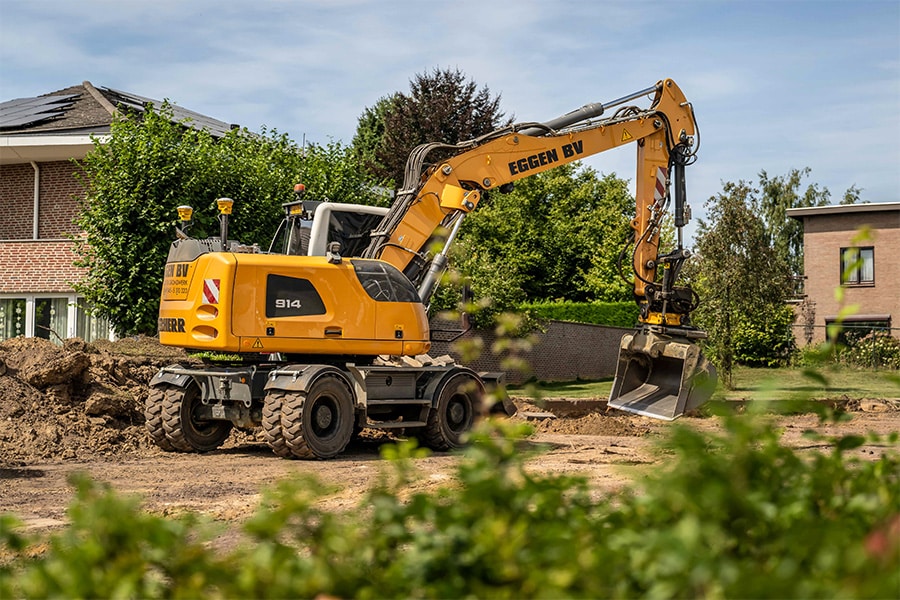
First national NEN 7201 Self-declaration 'Test load of foundation piles'
The pile class factors for the pile tip (αp) for all pile types were reduced by 30% by the Geotechnical Standards Committee on January 1, 2017, because tests showed that the design values used until then did not demonstrably guarantee the level of reliability required by law. In other words, the foundation piles may have less bearing capacity than assumed. There is an exception to this rule, however. When test loads are performed, the resulting, higher values of the pile class factors may be adhered to. Together with All Piles Testing Services (APTS), Verhoef Funderingstechnieken carried out all the necessary load tests and was the first to receive the national NEN 7201-Self-declaration "Test load of foundation piles" on its Olivier piles in late 2022.
Bearing capacity calculations for pile foundations are based on the requirements of NEN 9997-1 (Eurocode 7 with National Appendix). Since January 1, 2017, this has reduced the pile class factors for the pile tip of all pile types by 30%. This was decided by the Geotechnical Standards Committee, in which the entire geotechnical industry in the Netherlands is represented. "This means that since then, design with deviating (higher) pile class factors is only allowed in the case that they are legitimized by test loads," said Gilliam de Nijs, director of All Piles Testing Services (APTS), which conducts one hundred and fifty to two hundred pile tests annually.


NPR 7201
Broadly speaking, said pile tests fall into two categories, namely tests whose found design values have validity only for that specific project location where the tests were also performed. And a combination of tests whose found design values have nationwide validity and therefore may be used at any project location in the Netherlands. "A guideline was drawn up by the Geotechnical Standards Committee with the aim of establishing uniform test procedures for different test forms (test classes). The result is recorded in NPR 7201," De Nijs clarifies. "This guideline provides instructions for the execution, elaboration and interpretation of in situ test loads with axial forces on foundation piles. Depending on the chosen test form, the results can be used for the determination/determination of, for example, the maximum bearing capacity on compression and tension; the pile class factors; the characteristic load-sagging behavior and load-rising behavior of the piles for the benefit of the design of the pile foundation; the testing of the load-sagging behavior and load-rising behavior of the piles of the foundation to be investigated."

Two trials
As part of the proposed reduction of the pile class factor for the pile tip (αp), Verhoef Funderingstechnieken decided at an early stage to perform pile tests on its Olivier piles according to NPR 7201. The purpose of these tests was to establish unambiguous and nationally applicable pile class factors for this specific pile system. With this objective in mind, the class A1 tests described in the NPR 7201 were carried out under the supervision of APTS at two locations in the Netherlands, a test load in Terneuzen in 2016 on three Olivier piles (310/460) and then in Utrecht in 2021 on three Olivier piles 360/560. De Nijs: "At the Terneuzen location, the test piles were loaded monotonically, while in Utrecht a cyclic loading schedule was followed. In addition, because of the typical pile shape of an Olivier pile, extensive attention was paid to determining the actual concrete E-modulus of the tested piles. Thus, one of the piles was drawn. The pile in question was cut into 1.5-meter segments after which they were tested in a compression bench using the same load steps as during the Class A1 test load. In this way, a highly reliable axial stiffness EA of the concrete of the tested pile was established and thus reliable pile class factors."

Optimal security without overkill
The results of the test loads provided important knowledge about the load-sagging behavior of the Olivier piles and also determined new nationally applicable pile class factors, namely: a core diameter related αp-value of 0.5338 and a pitch diameter related αs-value of 0.01132. De Nijs: "It is concluded that for the Olivier pile system the load-sagging behavior exactly matches the load-sagging line 1 from the NEN-EN 1997-1+C2-2017 chapter 7.6.4.2. A foundation design based on nationally recognized pile class factors thus guarantees an optimal safety level without overkill. In addition, the sustainability of a foundation design is optimally served, as no more materials go into the ground than necessary for a safe design. The Olivier Pole is the first to be listed on the NEN website with the new national A1 test-based factors, but certainly not the last. As ATPS, we are happy to be of service in this regard."




